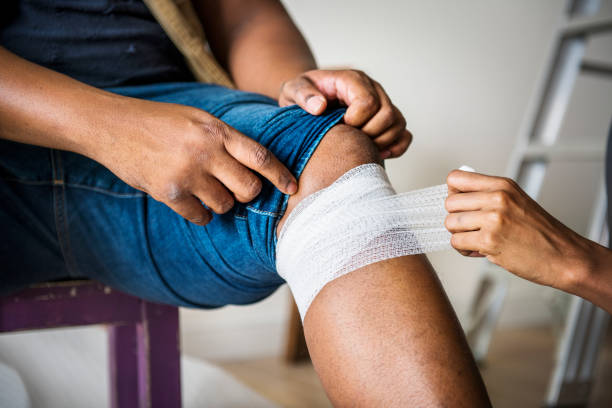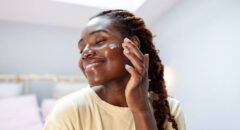
Caring for your hidradenitis suppurativa (HS) wounds is an important part of promoting healing and preventing infection. Not sure where to begin? These wound care tips protect your skin from irritation and infection.
1. Talk to your doctor.
The recommended dressings and cleaning instructions vary based on the severity of your wounds, their location and how well they are healing, so if you are not sure how to properly care for your wounds, your doctor can offer some guidance.
2. Clean your wound about once a day.
After your surgical treatment, it is important to wash your wound once a day with soap and water. This will help remove any buildup of liquid draining from the wound and any petroleum used to keep the wound moist.
3. Wash gently with mild soap and water.
The type of cleanser you use is important. When washing, always opt for a mild cleanser and steer clear of harsh soaps, scrubs and rubbing alcohols, which are rough on the skin and will only make things worse for you.
It is also important to remember that cleaning wounds aids in healing, but it won’t make HS go away completely.
4. Use petroleum jelly.
Petroleum jelly is a great tool to keep your wound moist. When using petroleum jelly, apply a thin layer to the wound before you place a dressing on it. This will soothe the wound and aid in healing it. What’s more, petroleum jelly prevents the dressing from sticking to the top layer of your skin, which can be painful as you are removing the dressing.

5. Choose the right dressing.
Another important step in wound care is choosing the right dressing. The key is to choose a dressing that will absorb the fluid because after surgery, the wounds from the inflammation of HS can create a lot of liquid and drainage.
If the dressing doesn’t catch the drainage, it will sit against the skin, causing more irritation and getting in the way of your healing.
The good news is, you may be able to have your dressings covered by health insurance. If not, gauze works as well.
A gentle medical tape is ideal when applying the dressing to your skin. The tape should be placed a few centimeters away from the actual wound.
Hypafix is a good option for tape that if more flexible, breathable and gentle than other medical tapes.
6. Keep an eye out for possible signs of infection.
Although HS isn’t an infection, it is marked by pus (a commonly known sign of an infection). Many people are often misdiagnosed with an infection. However, infections in HS wounds aren’t as common as you may think. Still, it’s important to watch for danger signs if an infection does occur so that it can be treated early.
If you notice skin redness that starts spreading beyond the original lesions or if you have fevers or chills or other signs of infection throughout your body, it’s time to see your doctor.
7. Tailor your strategies based on where the wound is located.
Where is your wound located? If it’s in a hard-to-reach area, some tools can help. For example, if it’s on your buttocks, a large pad that is held in place by tighter underwear could be an easier solution than using multiple bandages on individual spots, Mayo Clinic notes. For wounds on your breasts, avoid bras that will rub and create friction.
8. Ask for more help if things aren’t healing.
You could be doing everything right and still not seeing the results you’d like, possibly because your immune system isn’t allowing the wound to heal. If that is the case, a dermatologist can help you find solutions to get the disease under control.

FAQ: Treating Hidradenitis Suppurativa (HS) Open Wounds
Hidradenitis suppurativa (HS) is a chronic skin condition that causes painful lumps, abscesses, and tunnels under the skin—often leading to open wounds. Proper wound care is key to healing and preventing infection. Below are answers to some of the most common questions about treating HS open wounds.
1. How do you treat hidradenitis suppurativa open wounds?
Treating HS open wounds focuses on keeping the area clean, reducing inflammation, and promoting healing. Here’s a general care approach:
- Cleanse gently: Wash the affected area daily with a mild, fragrance-free cleanser or antiseptic solution (such as chlorhexidine or benzoyl peroxide wash).
- Apply topical medication: Your doctor may recommend topical antibiotics (e.g., clindamycin) or anti-inflammatory creams.
- Dress the wound: Use non-stick, absorbent dressings to protect the wound and absorb drainage.
- Manage pain and inflammation: Over-the-counter pain relievers (like ibuprofen) and warm compresses can help.
- Avoid friction: Wear loose-fitting, breathable clothing to reduce irritation.
- Consult a dermatologist: In severe cases, your doctor may prescribe systemic antibiotics, hormonal therapy, or biologic medications.
Tip: Always follow your healthcare provider’s advice before trying new treatments or wound care routines.
2. Should you cover open HS wounds?
Yes, you should cover open HS wounds — especially if they’re draining or located in areas prone to friction (like the armpits, groin, or buttocks). Covering wounds:
- Keeps the area clean and protected from bacteria
- Prevents clothing from sticking to the wound
- Reduces odor and fluid leakage
- Promotes a moist environment that supports healing
Use non-adhesive, breathable dressings such as hydrocolloid or foam pads. Change them regularly, especially when they become damp.
3. How long does it take for an HS wound to heal?
Healing time varies based on the severity of the wound, your overall health, and the treatment used:
- Mild lesions may heal in 1–2 weeks.
- Deeper or recurrent wounds may take several weeks or months to heal completely.
- Chronic or tunneling wounds (sinus tracts) may not fully close without medical or surgical treatment.
- Keeping inflammation under control and avoiding new flare-ups helps speed recovery and reduce scarring.
4. Can a toddler have HS?
Hidradenitis suppurativa is rare in toddlers and young children. It typically appears after puberty, when sweat glands and hair follicles become more active. However, if a young child develops persistent boils, abscesses, or skin infections in the armpits, groin, or diaper area, it’s important to see a pediatric dermatologist. These symptoms might be due to:
- A bacterial skin infection (like staph)
- Folliculitis
- A genetic or immune-related condition that mimics HS
- Early evaluation helps ensure the right diagnosis and treatment plan.
Key Takeaway
While hidradenitis suppurativa can be challenging, consistent wound care, medical treatment, and lifestyle adjustments can help manage symptoms and improve healing outcomes. Always consult a dermatologist for personalized care.








